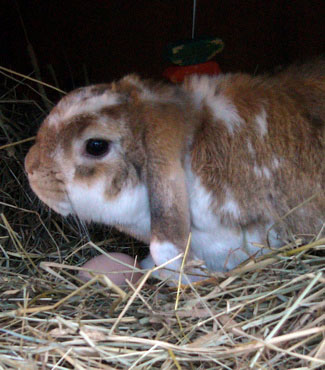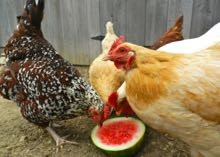I have a beautiful backyard. There’s the water feature, perennial flower bed, strawberry patch, herb garden, vegetable garden, shrubs, trees, and of course, the chicken coops and lovely chickens. What I don’t have is a nice lawn. Mostly, it’s crabgrass.
I won’t use herbicides because of the koi, dogs, chickens and kids, dragonflies and toads. I know that I need better soil, and I’ve already spent a lot of money on more loam and lime, punching those holes in the ground, over-seeding and organic fertilizers. I’ve tried the corn gluten treatment, which is supposed to inhibit crabgrass germination, but the dogs eat it, so I couldn’t do the required seasonal treatments.
The lawn is too large to weed by hand, but I do that anyway. I get a perverse pleasure from digging up crabgrass. The other day, I pulled some up and there were a half dozen grubs in the soil underneath. Yuck. So I started pulling up big chunks of turf. More grubs. I couldn’t stop and cleared whole areas of grass. Now there were patches of dirt — and grubs.
Obviously, I couldn’t take care of this grub infestation alone. I called in the clean-up crew – my chickens. Yesterday, I let Edwina, Ginger, Snowball and Twinkydink into the yard. I kept the dogs inside the house and kept an eye out for the hawks. The girls were ecstatic and clucked off happily into the leaves and the flower bed. Which is not where I wanted them. I wanted them to be eating grubs. Working.
I picked up Ginger and Edwina and put them next to me where I was pulling up crabgrass. Chickens are easy to train because they are so very food motivated. I made a kissy noise when I found a grub. I tossed it to them. In less than a minute the girls were scratching around me and running over when I called them to get the grubs. This was far easier for them than hunting for their bugs! They were delighted.
When done for the day, I was a bit concerned that it would be hard to get the girls back in their pen, after all, there was a whole wide yard of yummy things outside. But chickens are easy. I got a cup of corn, rattled it and called to them. The grubs were forgotten. That’s the nice thing about chickens – their optimism – there’s always something better around the corner.
I’m afraid that my battle against the lawn grubs is never-ending. But at least I have good company while out there.

